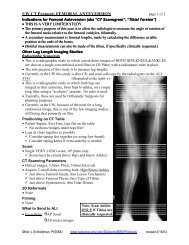Ankle and Foot 47 - Department of Radiology - University of ...
Ankle and Foot 47 - Department of Radiology - University of ...
Ankle and Foot 47 - Department of Radiology - University of ...
Create successful ePaper yourself
Turn your PDF publications into a flip-book with our unique Google optimized e-Paper software.
<strong>47</strong> <strong>Ankle</strong> <strong>and</strong> <strong>Foot</strong> 2277 <strong>47</strong><br />
Figure <strong>47</strong>-85. Example <strong>of</strong> a Lisfranc amputation<br />
in a 53-year-old who has had chronic peripheral<br />
neuropathy <strong>of</strong> unknown cause since 16 years <strong>of</strong> age.<br />
Lateral (A), anteroposterior (B), <strong>and</strong> (C) oblique<br />
radiographs. Cu, cuboid; 1, 2, <strong>and</strong> 3 indicate the first,<br />
second, <strong>and</strong> third cuneiforms.<br />
A<br />
B<br />
C<br />
bears his name, he did describe an amputation along the<br />
tarsometatarsal joint, an example <strong>of</strong> which is shown in<br />
Figure <strong>47</strong>-85.<br />
In a Lisfranc dislocation, the second to fifth metatarsals<br />
are dislocated laterally, or dorsolaterally, relative to the<br />
tarsal bones. The Lisfranc dislocations are subdivided into<br />
two categories based on what happens to the first metatarsal<br />
relative to the other four. If the first metatarsal dislocates<br />
laterally along with the second to fifth metatarsals, it<br />
is called homolateral (Fig. <strong>47</strong>-86). If the first metatarsal<br />
diverges from the other four metatarsals, remaining aligned<br />
with the medial cuneiform (Fig. <strong>47</strong>-87), or if the first<br />
metatarsal dislocates medially (Fig. <strong>47</strong>-88), it is called<br />
divergent.<br />
When a Lisfranc fracture is grossly displaced, a CT scan<br />
is not needed to confirm the diagnosis. However, because<br />
the exact location <strong>of</strong> dislocated metatarsals may be difficult<br />
to discern based solely on radiographs, a threedimensionally<br />
reformatted CT scan may prove useful in<br />
presurgical planning (see Figs. <strong>47</strong>-86H <strong>and</strong> <strong>47</strong>-87F <strong>and</strong> G).<br />
The three-dimensional nature <strong>of</strong> these dislocations can<br />
best be appreciated by creating a series <strong>of</strong> three-dimensional<br />
images rotated along longitudinal <strong>and</strong> transverse<br />
axes <strong>and</strong> played as a movie loop on the PACS. We find that<br />
a series <strong>of</strong> 36 images, each 10 degrees apart, works well.<br />
When only minimally displaced, Lisfranc dislocations<br />
can be difficult to discern radiographically, <strong>and</strong> close attention<br />
should be paid to the Lisfranc joint on all views <strong>of</strong> the<br />
foot. Normally there is perfect alignment between the first<br />
metatarsal base <strong>and</strong> first (or medial) cuneiform, between<br />
the second metatarsal <strong>and</strong> the second (or middle) cuneiform,<br />
<strong>and</strong> between the third metatarsal <strong>and</strong> the third (or<br />
lateral) cuneiform. Also, the bases <strong>of</strong> the fourth <strong>and</strong> fifth<br />
metatarsals should be perfectly aligned with their individual<br />
facets on the cuboid (see Fig. <strong>47</strong>-86A <strong>and</strong> B). One clue<br />
that a nondisplaced Lisfranc dislocation may be present is<br />
fracture fragments <strong>of</strong>f the base <strong>of</strong> the second metatarsal. As<br />
shown on the three-dimensional CT in Figure <strong>47</strong>-5, the<br />
base <strong>of</strong> the second metatarsal extends more proximally<br />
across the Lisfranc joint than do the other metatarsals.<br />
Thus, when dislocations occur along the Lisfranc joint, it<br />
Text continued on p. 2282<br />
Ch0<strong>47</strong>-A05375.indd 2277<br />
9/9/2008 5:35:24 PM
















